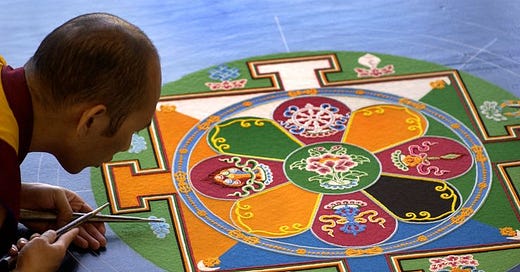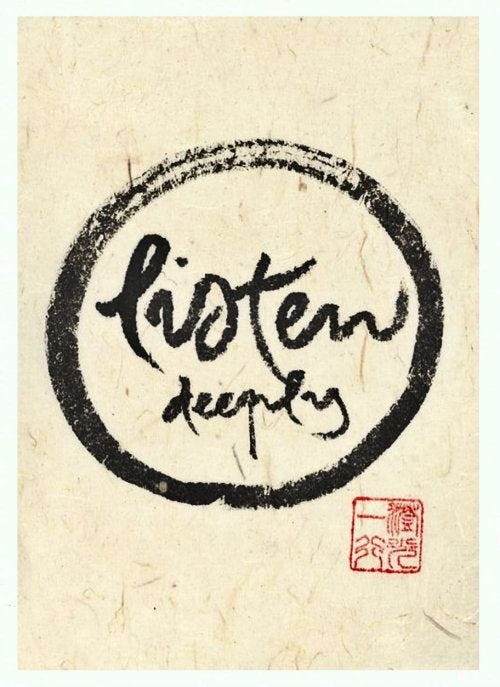If you could kindly tap the ❤️ at the top or bottom of this newsletter it will make it easier for other people to find this publication. Ahéhee'! བཀའ་དྲིན་ཆེ།! 謝謝! Thank you! ขอบคุณ! شكرا ! תודה! Спасибо! धन्यवाद! Cảm ơn bạn! អរគុណ! Merci y Muchisimas gracias!
Sawasdee khrap, dear friends. What a wild week it has been. Soaring to the hopeful heights in the wake of one of the largest collective protests in U.S history, a much needed reminder that no, most people do not appreciate nazi bullshit but prefer instead the majesty of cultural diversity. And then bam! We sank quickly back into despair as we saw yet more war escalating in the Middle East. These days are not for the faint of heart, to be sure. And yet here we are, whether we feel prepared for this moment or not, all of us being called to blossom in to good elders or rot in the plastic-filled ocean of forgetfulness and apathy.
We are six weeks into a bi-weekly exploration of The Seven Factors of Awakening as presented by the historical Buddha. For purposes of review, I am again posting the full list of factors here. It is always good to recollect, reflect and analyze each practice with more subtly, aspiring always to activate each quality with further refinement.
…
The seven factors of awakening (bojjhaṅga)
Mindfulness (sati)
Investigation (dhamma-vicaya)
Energy (vīriya)
Rapture (pīti)
Tranquility (passaddhi)
Concentration (samādhi)
Equanimity (upekkhā)
They are traditionally thought of in three groups:
One balancing factor: Mindfulness
Three energizing factors: Investigation, Energy, and Rapture
Three calming factors: Tranquility, Concentration, and Equanimity
…
Last week we briefly began our exploration of factor #5: Tranquility, the first of the “calming factors”. We discussed how Buddha deliberately placed the “energizing factors” before the calming factors in order to spark aliveness. For those who have been attempting to awaken these qualities with diligence over the course of that last month or so, you should now be feeling a noticeable balance of activation and peace, an unlikely marriage of seemingly opposing forces, a necessary tonic for these panic-obsessed times to be sure.
So now we journey deeper into the cultivating waters of calm. Concentration in this era of TiK-Tok and Snapchat is a truly endangered phenomenon. When I think about the kind of concentration people of old must have had to do so many of the daily tasks required of them I marvel. Engaging with people in this soundbite era of fast food and A.I. is like speeding through a neon-lit video arcade at 90 miles an hour with a head full of Budlight and L.S.D. People in this rootless generation of cultural displacement skip from one ungrounded topic to the next as fast as Trump changes his mind about tariffs. Such instability of focus makes it very hard to have any solid view whatsoever beyond the simple yearning to survive and be occasionally entertained. Indeed, these times don’t offer us the ideal conditions for genuine awakening. Nonetheless, if we are ever going to become the leaders we wish we had, we will need to considerably level up our ability to concentrate.
A Tibetan monk painstakingly “paints” a sand mandala
…
Concentration (samādhi)
Concentration is the common translation of the complex word samādhi, which describes the states of immersion, deep stability of attention, and one-pointedness that develop primarily in meditation. Immersion refers specifically to the four jhānas—states of meditation that can arise when the hindrances are absent and tranquility and steadiness are strong. The jhānas begin with states where active thought and investigation are needed to keep attention steady, and deepen through states where rapture, easeful happiness, and finally profound stability and luminosity are prominent. Samādhi is also used to describe daily life states of flow and effortless engagement outside of formal meditation, states in which pleasure and ease support sustained clarity of mind.
-Sean Oakes
Imagine how different our world would be if we could pay attention to something long enough to merge our understanding with the understanding of what/whomever we observed. Imagine if we could see deeply enough into the subtle works of a Baroque fugue that we could literally see its mathematical intricacy, its legendary formality, its mesmerizing symmetry and exquisite variety with the same vivid luminosity as a Tibetan sand mandala “painter” sees each colorful, miniscule sand granule as they course through the tiny corridors of the chak-pur, slowly building a Kalachakra Mandala to house the 722 deities whom reside within the eloquent rooms of the complex structures intricate geometry.
Lying dormant in us is an extraordinary opportunity to focus with such powerful stability that we can even heal many of our ailments with mere thought, coupled with breath. I will stop here with that one, for fear or the pseudoscience crowd hijacking a well-documented practice, but I assure you, it can be done. It isn’t really all that hard. Sit silently before dawn each morning for only 5 minutes. Be still. Breathe in, breathe out. Focus, on nothing in particular. Just be. Do this every day. Concentrate. Put the phone in the other room. Breathe in, breathe out. Rest. Listen deeply, let go…
I began this little series on The Seven Factors of Awakening six weeks ago, in response to readers emailing me about how we might better show up to the protests emerging around the globe. I hope these brief meditations have proven to be of some benefit. We must remember that we cannot be anti-war while being at war with war and thus becoming what we aspire to transcend. We must place at least as much effort on generating the ability to transform inwardly as we place on attempting to have influence on the external realms. For, peace in the world around us will not come into view until we have learned how to cultivate peace within ourselves.
I did not attend a No Kings Day protest as I live in a small village in the Northern jungles of Thailand where our days are consumed mostly with placing seeds in soil. But I did sit for several hours that day, well before the sun rose, concentrating deeply on metabilizing the profound teachings of master Thích Nhất Hạnh whom, for all his life, worked directly with socially engaged buddhists in a tireless effort to transform hate into love, war into peace, and ignorance into insight. He often reminded us that we all inter-are. As such, although I am here and you are there, I was with you on the streets dear friends, speaking truth to power, and in turn, you were sitting alongside me, breathing mindfully. As the sun rose, we drank tea together and I danced with you in front of a heartbroken National Guard. Peace in oneself, Peace in the world.
I will end this weeks reflection with the words of Zen priest, Peter Coyote, on protest:
"I’m watching the Los Angeles reaction to ICE raids with trepidation and regret.
Three years ago I taught a class at Harvard on the “theater of protest”— designed to help people understand why so many protests turn out to be Republican campaign videos working directly against the interests of the original protest.
A protest is an invitation to a better world.
It’s a ceremony.
No one accepts a ceremonial invitation when they’re being screamed at.
More important you have to know who the real audience of the protest is.
The audience is NEVER the police, the politicians, the Board of supervisors, Congress,etc.
The audience is always the American people, who are trying to decide who they can trust; who will not embarrass them.
If you win them, you win power at the box office and power to make positive change.
Everything else is a waste.
There are a few ways to get there:
1. Let women organize the event. They’re more collaborative. They’re more inclusive, and they don’t generally bring the undertones of violence men do.
2. Appoint monitors, give them yellow, vests and whistles. At the first sign of violence, they blow the whistles and the real protester sit down.
Let the police take out their aggression on the anarchists and the provocateurs trying to discredit the movement.
3. Dress like you’re going to church. It’s hard to be painted as a hoodlum when you’re dressed in clean, presentable clothes.
They don’t have to be fancy they just signal the respect for the occasion that you want to transmit to the audience.
4. Make your protest silent. Demonstrate your discipline to the American people. Let signs do the talking.
5. Go home at night. In the dark, you can’t tell the cops from the killers. Come back at dawn fresh and rested.
I have great fear that Trump’s staging with the National Guard and maybe the Marines is designed to clash with anarchists who are playing into his hands and offering him the opportunity to declare an insurrection.
It’s such a waste and it’s only because we haven’t thought things through strategically.
Nothing I thought of is particularly original.
It was all learned by watching the early civil rights protests in the 50s and 60s.
And it was the discipline and courage of African-Americans that drew such a clear line in the American sand that people were forced to take sides and that produced the civil rights act.
The American people are watching and once again if we behave in ways that can be misinterpreted, we’ll see this explained to the public in Republican campaign videos benefiting the very people who started this.
Wake up.
Vent at home.
In public practice discipline and self control.
It takes much more courage."
— Peter Coyote
Zen teacher and author/narrator, with Ken Burns
Note: Carry an American flag. As the administration creates a fake emergency to justify a state crackdown, it's important to honor the values and vision of democracy for which we're advocating.
When the Enquirer came for pics back in 2017, I smiled a big toothy grin and held a big flag as it felt so empowering and good to stand with my adult daughter, pastors, Franciscans, nuns, kids, parents, grandparents and some women from our women's groups for the values we tried to pass on.
After the protest, we sang and marched to a church where we heard poignant witness of immigrants trying to build a better life for their families against insurmountable odds.
Many Marines, National Guardsmen and vets are over on Threads and Substack expressinging their disagreement over being used by this lawless administration.
Peace, santi and shalom to all.
…
or…
#maypeaceprevailonearth
If you could kindly tap the ❤️ at the top or bottom of this newsletter it will make it easier for other people to find this publication. Ahéhee'! བཀའ་དྲིན་ཆེ།! 謝謝! Thank you! ขอบคุณ! شكرا ! תודה! Спасибо! धन्यवाद! Cảm ơn bạn! អរគុណ! Merci y Muchisimas gracias!






Thanks for this excellent post, Gregory. Since the invasion of Iran, I've been making time every day to paint, and it might be fulfilling my need for concentration. It's very meditative.
And those are excellent pointers about protests.
🙏🏼